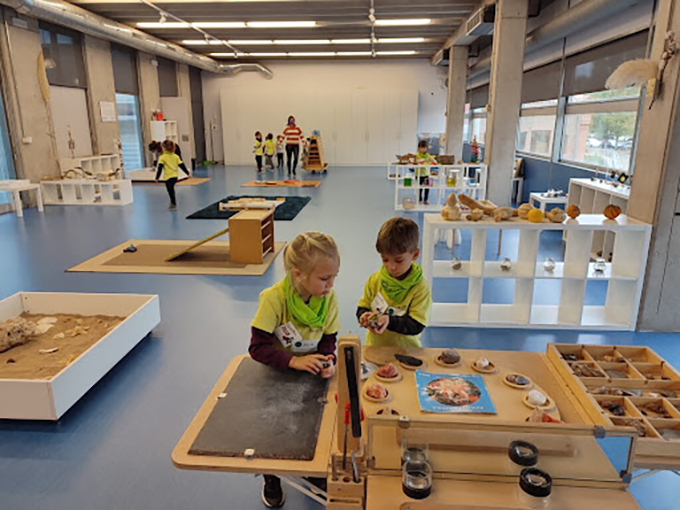
The laughter, noise and hubbub of children often resonate in the Faculty of Social Sciences of Manresa of the University of Vic-Central University of Catalonia. An academic context for training teachers who are not afraid of contact with infant schoolchildren (from 3 to 6 years old), in which we have created a laboratory designed to bring science closer to the youngest children.
This is Lab 0_6, a discovery, research and documentation centre for scientific education in early childhood . A space created by our team of education researchers that puts young children in direct contact with phenomena and materials that belong to the field of science.
A free-choice science space
We are talking about an open space, arranged with proposals that mobilize scientific ideas, where children from 3 to 6 years old enter with the instruction that they can go wherever they want, for as long as they want, with whomever they want and act on the materials with initiative. The only restriction is to maintain respect for materials and classmates, as in any other social activity.
Offering free action in an attractive space filled with stimulating materials makes children experience it as a game. As the Russian psychologist Lev Vygotsky reminds us , during play the child grows, he is a head taller than he really is. While for them it is a game, those of us who have designed the room have made sure that this game has learning value from the point of view of science.
A basic criterion in the creation of proposals
For this reason, as various authors explain , all the proposals of the space follow a basic criterion: they must be focused but open. Focused because they clearly aim to mobilize an idea of science, but open because we want to promote the initiative of children and, therefore, they are never proposals with a single response.
The difficulty, and at the same time the value, lies in finding those materials and that arrangement that favor that, in a natural way and without impositions, the actions of the children in the proposal fit with the learning intentions of the adults.
For example, one proposal consists of two levers, apparently identical, although one has the axis in the centre and the other off-centre, and a collection of pieces, cubes of the same size but of different materials. The intention of the adult is for the children to realise two factors: the importance of the weight of the object and the distance from the axis in order to balance a lever, while putting them in contact with materials of different densities (same volume, weight varies).
Obviously, these are not the conclusions that students reach after a limited time of interaction with the proposal, but they provide direct experience on how the lever works and generate curiosity, questions and challenges that can continue in school.
A successful proposal
Lab 0-6 UManresa is a successful proposal. It fills up in the first week of registration opening, so we can only respond to a small part of the requests. The children enjoy the session and leave seduced by some of the ideas or challenges experienced. For their part, the teachers live the visit with enthusiasm and leave very encouraged to introduce science into their classrooms, while realizing that science is not something unattainable in early childhood education. As for the teaching staff from other universities who visit us, they agree on the value of finding a natural way to bring science closer to the youngest children. And in the educational team we enjoy trying new proposals and we feel very satisfied with the success.
For our proposal we have based ourselves on published evidence , such as that the game constitutes a favourable context and an effective strategy for learning: these ideas have brought us closer to the construction of the space with rigorous proposals. But we do not yet have specific results on our Lab 3-6: we will check its real impact in future research.
This is the aim of the IMPACTLAB project, currently in its first year: to identify what improvements in the approach to science occur in early childhood schoolchildren after three visits over the course of a school year. Are their interactions with the proposals more elaborate? Does the type of questions they generate change? Do they find new creative ways to solve the challenges? Is there greater control over the phenomena? Are they able to explain them more precisely?
This is our current challenge, a fascinating challenge whose conclusions we hope to explain soon.
Author Bios: Judith Sabido-Codina is Professor of Social Sciences Education, Gabriel Lemkow Tovias is Professor Lector, member of the teaching team of the Degree in Early Childhood Education, Member of Lab0_6, Irene Tort Cots is Professor of Master’s Degree in Early Childhood Education. PhD specializing in language and literature teaching, Loli Vazquez Carrasco is Coordinator of the Early Childhood Education Department and Montserrat Pedreira Alvarez is Director of the Degree in Early Childhood Education. Faculty of Social Sciences of Manresa (UVic-UCC) all at the University of Vic – Central University of Catalonia
